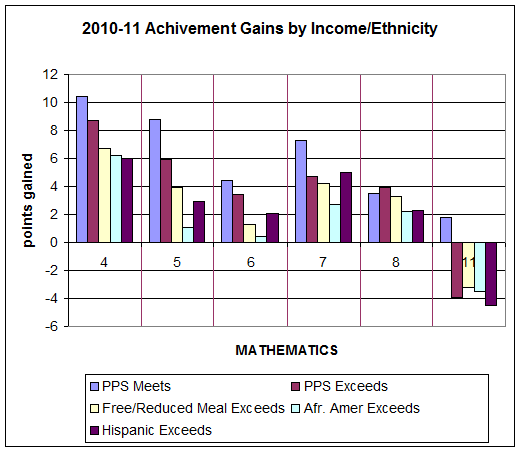
Portland Public Schools 2010-11 Achievement Gains
Check this out first: PPS Assessment Overview: Student Gains by Performance Level
The tables below break out the "meets" and "exceeds" portion of the "Overview" graph by grade level, income and ethnicity:
2010-11 Meets and Exceeds; Exceeds broken out by Income and Ethnicity
| READING | ||||||
| PPS | PPS | F/R Meal | Afr. Amer | Hispanic | ||
| Grade | Meets | exceeds | exceeds | exceeds | exceeds | |
| 4 | 7.7 | 5.1 | 3.8 | 3.9 | 4.4 | |
| 5 | 5.2 | 2.3 | 1.6 | -0.2 | 1.3 | |
| 6 | 4.8 | 3.8 | 2.9 | 1.7 | 3.1 | |
| 7 | 6.7 | 5.4 | 4 | 2.7 | 3.1 | |
| 8 | 1.7 | -1.4 | -1.7 | -1.7 | -1.9 | |
| 11 | 5.3 | 1.6 | 2.2 | 0.2 | 2.2 | |
| MATHEMATICS | ||||||
| PPS | PPS | F/R Meal | Afr. Amer | Hispanic | ||
| Grade | Meets | exceeds | exceeds | exceeds | exceeds | |
| 4 | 10.4 | 8.7 | 6.7 | 6.2 | 6 | |
| 5 | 8.8 | 5.9 | 3.9 | 1.1 | 2.9 | |
| 6 | 4.4 | 3.4 | 1.3 | 0.4 | 2.1 | |
| 7 | 7.3 | 4.7 | 4.2 | 2.7 | 5 | |
| 8 | 3.5 | 3.9 | 3.3 | 2.2 | 2.3 | |
| 11 | 1.8 | -3.9 | -3.2 | -3.5 | -4.5 | |
Notes:
These tables and graphs were compiled in 2011 from data on the Portland Public Schools website, in the section for "Testing". See http://inside.pps.k12.or.us/depts-c/rne/results/2010/perfGrowth09.php?resultYear=2011&school=distr . Numbers from several different tables were combined and a graphing program was used to display the numbers.
This report includes students who have a valid score from both 2009-10 and 2010-11.
The data for "gains" subtracts student achievement test scores for each student in 2010 from the achievement test score for the same student in 2011 except in the case of eleventh-grade gains. As there is no ninth or tenth grade test, the scores of students from 2008, when they were in the eighth grade, are subtracted from their scores for 2011 when they were in the eleventh grade. This is the first time that PPS has tested students in eleventh grade instead of tenth grade. Students taking the test are grouped by ability in five groups: "Very Low, Low, Nearly Meets, Meets, and Exceeds."The first two columns of the graph compare the gains for students who exceeded the benchmarks with gains for students who met benchmarks. In addition, score gains for Free and Reduced Lunch, African-American, and Hispanic American students who exceeded benchmarks in the previous test are shown.
The chart and graphs represent a "snapshot," not a trend. It does NOT trace gains from third grade to tenth grade for a single cohort of students. It compares the gains achieved by students in different grades who all took one test last year and another test one or two years previously.
The chart and graphs only represent student learning for the curriculum that was included in the test and may not fully represent what students actually covered or learned during a year.
Please note that the scales for the two charts are not the same. Math runs from -4 to 10 (14 points) while Reading runs from -6 to 12 (18 points).
In addition, results might look different if confidence bands were included.

